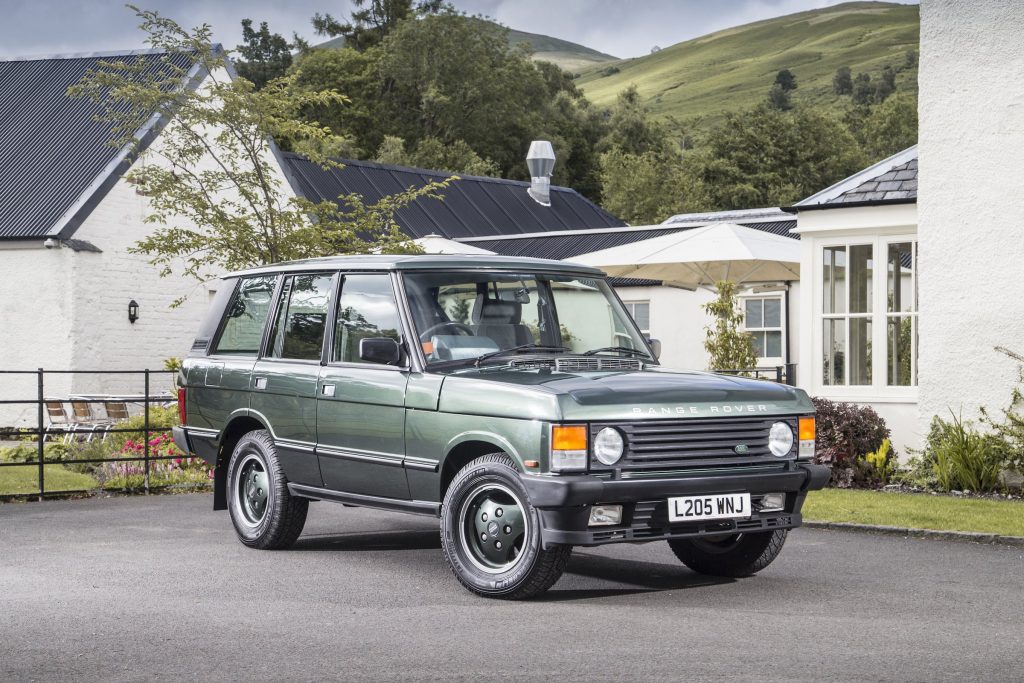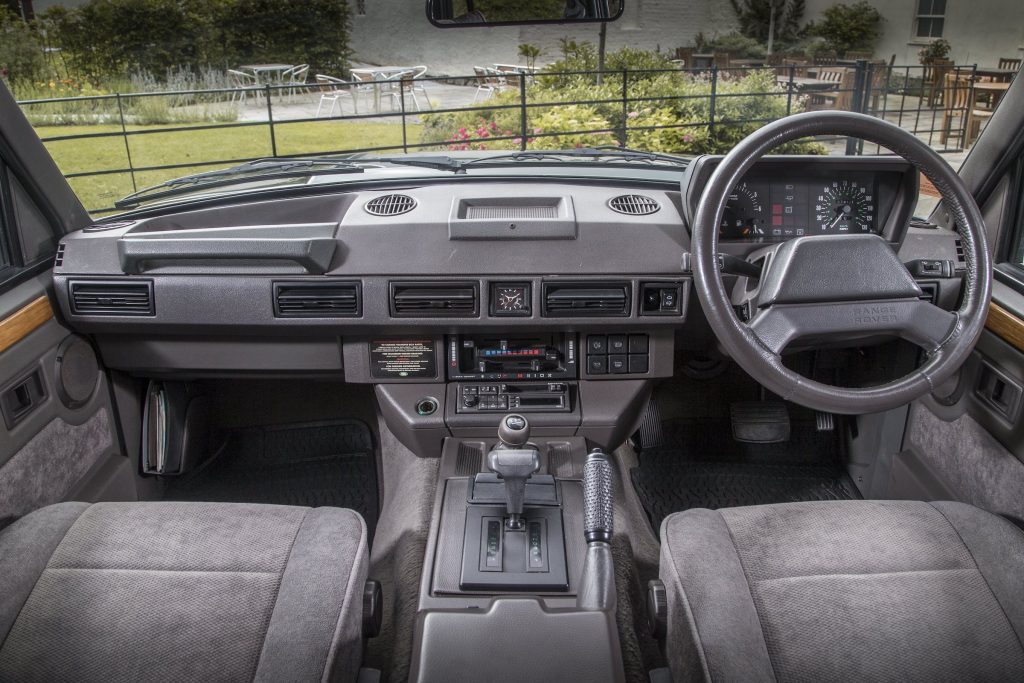The original Range Rover is such a classic that today it’s known almost universally as the Range Rover Classic. So why am I suggesting it in a column about future classics? Only because regardless of how it has been come to be known, I don’t think it’s got there yet. Ok, to be fair, some have. The earliest cars, with the three door body shells, can now command astronomic asking prices in fully restored condition, but cars from the more recent end of production are a fraction of the price. And, for most people most of the time, they’re better too.
Let’s recap, just for a moment. Why is this old SUV so revered? One reason is that it is perceived to be the original luxury off-roader, the grand-daddy not just of the modern Range Rover, but all those Bentleys, Porsches, Astons and more that have followed in its footsteps. And the fact that this is entirely inaccurate is really neither here not there. The first true luxury SUV was the 1966 Jeep Super Wagoneer, but why let the truth get in the way of a good story?

Besides, almost none of the cars that created new categories ever got the credit for it. Was the Golf GTI the first hot hatch, the Renault Espace the first MPV, the Audi Quattro the first high performance 4×4, the Lamborghini Miura the first mid-engined supercar, the McLaren F1 the first all carbon road car or the Porsche 911 Turbo the first turbocharged road car? No, no, no, no, no and – you guessed it – no.
What the original Range Rover did, like so many of the cars named above, is take the concept and perfect it. And it was quite brilliant: in 1970 here was a car with a well appointed interior, a smooth and sonorous V8 motor, all the luggage space you could want and good looks too. It would have sold even if it wasn’t ridiculously good off road, but with a ladder chassis and live axles at both ends, it could clamber its way up, down, across, through and around terrain that would make a billy goat look twice. It was the ultimate adventure device in a family friendly format which meant it could serve not as a narrowly focussed workhorse, like a Series Land Rover, or a toy, but as the only car you and your family might ever need, more likely to be seen as an alternative to a posh Mercedes than any other off roader.

But those early cars, lovely as they are, are quite limited. The three door shell is iconic, but it restricts access, the 3.5-litre carb-fed V8 is not very powerful and the four speed manual gearbox an acquired taste. Very early cars didn’t even have power steering.
Contrast that to the Range Rover I’m touting as a future classic, the 3.9-litre car introduced in 1989, almost 20 years after the first. By then the car had evolved meaningfully and came with four doors, automatic transmission, power steering, anti-lock brakes, a far more plush interior, much better refinement and a genuinely comprehensive level of equipment. More importantly still, engine power had risen from 135bhp to 182bhp, but thanks to fuel injection replacing carburation, consumption had actually improved too. Its bluff shape still limited top speed to 110mph, but that was a vast improvement on the 95mph of the early cars. The 0-60mph time was cut from a little under 15sec to a little over 11sec, too.
I used to love knocking about in these when they came in for testing. I loved their languid nature, their throaty voices, the wonderfully elevated driving position and the fact that it had this entire other dimension to its character the moment you left the road. It was like a superhero, a suave businessman one moment, the ultimate outdoor adventurer the next.

So why aren’t I arguing the case for the ultimate ‘classic’ Range Rover, the 4.2-litre, long wheelbase LSE brought at the end of its life? Largely because the 4.2-litre motor was not as strong as the 3.9 and the air springs on which it rode are more troublesome than the coils they replaced.
You can pay peanuts for a late Range Rover but I’d advise against it and not just because, like so many old cars, whatever you save at the time of purchase you’ll likely spend maintaining it. It’s also worth bearing in mind that most of the Range Rover’s body is aluminium (the main exception being the tailgate), which is great news because it is incredibly corrosion resistant. Don’t forget however, that it’s bolted to a steel chassis that can and does rust. So don’t fall for a car that looks great on the outside without having a very good look underneath and through its service history to make sure the chassis is in good nick too.
Prices of really nice cars seem to start at around £20,000, which isn’t much for such a fine car and really very little indeed compared to what you’d pay for an early car in similar condition. If you’ve lived with one of these, share your experiences, below.
Check out the Hagerty Media homepage for daily news, features, interviews and buying guides, or better still, bookmark it.










I loved my 200TDi, in the same Ardennes Green as the one pictured above. But it began to show its age, and I reluctantly sold it to a wildlife photographer in town, believing that I would see it occasionally, but not everyday. But after a couple of months he sold it to my neighbour who’d introduced us, so I saw it every day.
And I also saw how he treated it, using it mainly to ferry tubs of water up a lane to see to his sheep. Then for some reason he started to leave his dogs in the back of it during the day, and their damp breathing brought the headlining down.
Eventually I got a call from him… his wife was stuck in it in town because it wouldn’t start. I drove in with the Freelander and gave her a tow start, diagnosing it was the solenoid that had failed. I printed off all the relevant pages from the workshop manual to help him fix it, but in a day or so he’d taken it to the local scrapyard. The wheels alone were worth what they paid him for the whole car. I tried to buy it back, but it had already been registered as ‘Scrapped’. I have the green oval badge off the grille as a souvenir.
My heart still lifts when I see a Classic on the road. An iconic car.
Only problem is none of them are ULEZ compliant.
Sad story Graeme but enjoy reading it. Always want her classic car but maintenance is so key to keep the story alive.
I have a 200tdi Vogue in Westminster grey as my daily car, it’s the only car I’ve ever owned that doesn’t leave me feeling there is something another car would be better at. It does everything everywhere. I love it.
I have two that are stored at my farm I was hoping to get the restoration on them one is an L reg and a k reg I’m getting too old now to get them done but I’m happy to keep them in storage for future times Both are diesel
I’ve had 6 Range-Rovers from different periods !! The air suspension was an expensive disaster, though when it worked was nice to get old folks in and to load when the suspension was down !!My last one drove like a rock when the suspension went !!
I chose J reg. Before cats and air but with antirollbars. The early models made me seasick. Mine had a cracked cylinder liner which screwed up cooling, the heater matrix blew giving instant fog inside. Re ULEZ is it not true that any over 40 are historic vehicles and therefore exempt?
You’re right, Tim. Full details about ULEZ and its impact on drivers can be found here: https://www.hagerty.co.uk/articles/news-articles/what-the-ultra-low-emissions-zone-means-for-londons-classic-car-owners/
I’m the lucky owner of a 1989, 3-door, EFI Range Rover with factory fitted automatic transmission and (working) AC.
Perfectly restored by ASP Grand Garage at Jouy-le-Chatel, with thanks to Cyrille Coadou.
The Range is a joy to drive and the high-up seating is incomparable to any other car on the road.
I may now be in the market for a 3.9 4-door as well.
After having and rebuilt a 1976 2 door Range Rover which I ran for a few years and I really enjoyed driving the car with its unlimited suspension travel. I purchased a four door 1993 Range Rover 3.9 back in 2005 and still use this car and after a rebuild back in 2010 what a car I really enjoy driving this one she gets out once a week through the summer months. My every day drive is a 2004 L322 4.4 petrol and what a car this is.
I must admit I’ve enjoyed driving all these Range Rovers, I’ve driven the p38 diesel 2.5 which I must admit I didn’t think was refined enough and all be it a bit slow so always had to boot it to make it move. But all said what a fantastic car this is and I’ve always admired these cars ever since I can remember